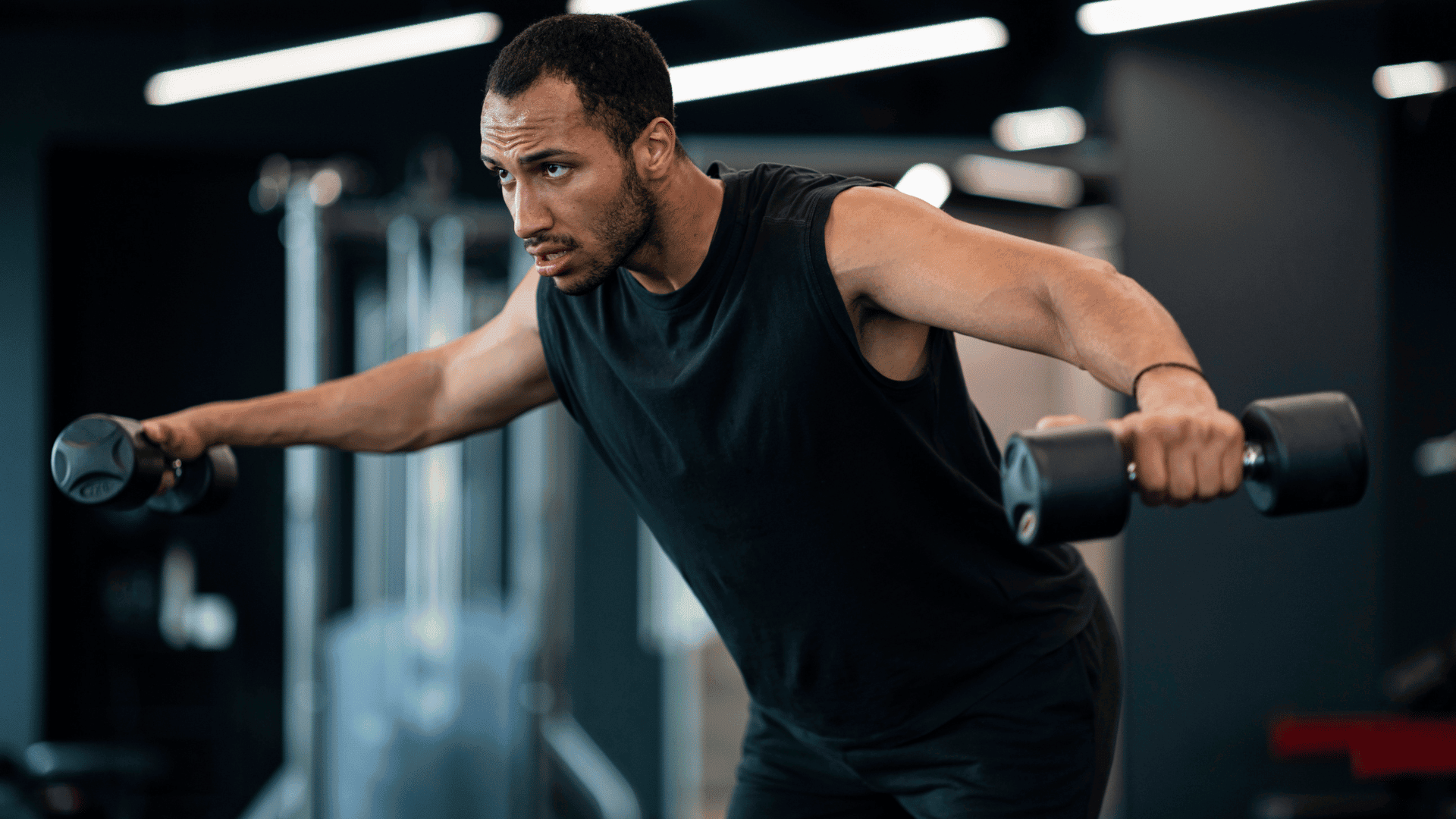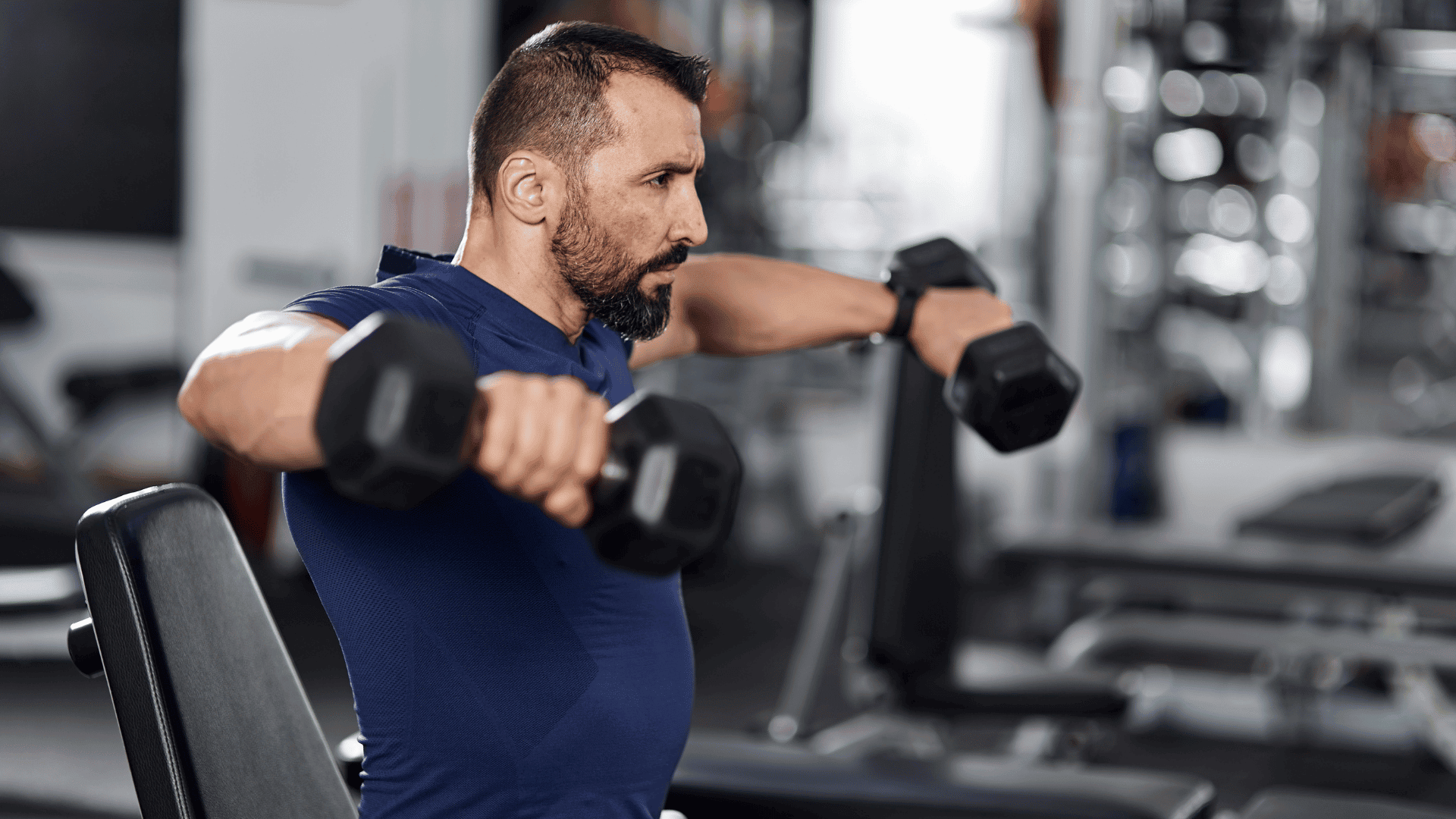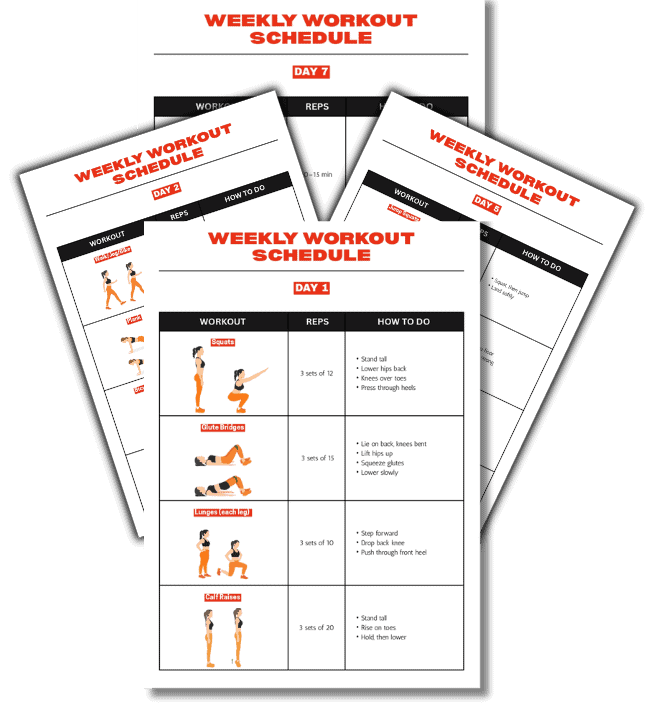If you’ve ever looked in the mirror and felt like your upper body was missing something, chances are it was shoulder shape. Broad shoulders give your frame balance, make your chest look stronger, and create that wide, athletic look most men want.
When shoulders are strong, they also protect your joints and support better posture. Simple things, like pressing weight overhead, carrying groceries, or throwing a ball, become easier because your upper body works together instead of relying only on chest or arms.
The issue is that many guys skip focused shoulder work. Chest and biceps get plenty of attention, while the shoulders get left behind. The result is an unbalanced look and weaker lifts over time.
But don’t worry.
Because in this blog post, you’ll get 9 shoulder workouts for men that hit every part of the muscle, the front, the sides, and the rear. The exercises are clear, beginner-friendly to start, and include progressions so you can steadily build broader, stronger shoulders.
Why Training Your Shoulders Matters

Strong shoulders are more than just a way to look bigger. They keep your upper body balanced, protect against injuries, and support almost every movement you make with your arms.
The shoulders are made up of three parts:
- The front, which helps with pressing and lifting objects overhead
- The side, which creates width and supports movements out to the side
- The rear, which controls pulling and keeps your posture upright
Each part plays a role in how you push, pull, and lift. If one area is weak, the others work harder to make up for it. That imbalance often leads to poor posture, weaker performance, or strain.
Training all three parts evenly builds strength and stability. This carries over into your lifts at the gym, your performance in sports, and even simple tasks like carrying groceries or reaching overhead. It also adds width to your frame, giving you a broader and stronger look.
Beginner Shoulder Workouts for Men
When you are starting out, the goal is to learn proper form and build a base of strength.
These exercises cover all three parts of the shoulders and can be done with light weights, bands, or even household items.
1. Overhead Press
Sit or stand with your feet shoulder-width apart and hold a dumbbell in each hand at shoulder height. Keep your palms facing forward and your elbows under your wrists.
Press the weights straight up until your arms are almost fully extended, then slowly lower them back down to shoulder level. Focus on moving with control rather than rushing.
This exercise works the front and side of your shoulders while also engaging your core for stability.
Beginners should start light, even with filled water bottles, to master the motion before adding heavier weights.
2. Dumbbell Lateral Raise

Stand tall with a dumbbell in each hand at your sides. Keep a slight bend in your elbows and lift your arms out to the sides until they are level with your shoulders. Slowly lower them back down to your sides.
Avoid swinging the weights or using momentum. The goal is to feel the side of your shoulders working.
If you are new, start with very light weights or even no weight at all, focusing on proper form.
3. Bent-Over Reverse Fly

Hold a pair of light dumbbells and bend at the hips so your torso leans forward slightly, keeping your back flat. Let your arms hang straight down with palms facing each other.
From here, raise your arms out to the sides in a wide arc until they are level with your shoulders, then lower them back down with control.
This move strengthens the rear part of your shoulders, which is often neglected but important for good posture.
Beginners can also perform this with just their bodyweight by mimicking the movement until they are comfortable adding weights.
4. Upright Row

Hold a barbell, dumbbells, or even a resistance band in front of your thighs with your palms facing your body. Keeping the weights close, pull them upward toward your chest by leading with your elbows.
Stop when your elbows reach shoulder height, then slowly lower the weight back down. This exercise works the front of your shoulders as well as the traps.
Beginners should use a light load and focus on smooth movement to avoid straining their joints.
Intermediate Shoulder Workouts for Men
Now that you’ve learned all four beginner shoulder workouts for men and built a solid base, it’s time to level up.
These next exercises add more volume and challenge your shoulders from new angles to help you grow stronger, wider, and more balanced.
5. Push Press

Stand with your feet shoulder-width apart and hold dumbbells or a barbell at shoulder height. Dip your knees slightly, then drive upward by pushing through your legs and pressing the weights overhead in one smooth motion.
Slowly lower the weights back down to your shoulders. The leg drive helps you lift more weight than a strict press, making this a powerful move for strength and size.
Keep your core tight and avoid leaning back as you press.
6. Arnold Press

Sit or stand with dumbbells in front of your shoulders, palms facing you. As you press the weights upward, rotate your wrists so your palms end up facing forward at the top. Slowly reverse the motion as you bring the weights back down.
This exercise works your shoulders through a longer range of motion and challenges the front and side muscles together.
Use moderate weight and focus on smooth rotation to avoid straining your joints.
7. Rear Delt Row

Hold dumbbells in front of your thighs with palms facing your body. Bend at the hips until your torso is leaning forward, keeping your back flat.
Pull the weights up and slightly out to the sides, aiming to bring your elbows high and wide. Lower the weights with control.
This move targets the rear shoulders and upper back, which balance out all the pressing you do for chest and front shoulders. Strong rear delts improve posture and help prevent shoulder injuries.
8. Face Pulls
Anchor a resistance band at chest height. Hold one end in each hand with your arms extended.
Pull the band toward your face, leading with your elbows and keeping your wrists high. Squeeze your shoulder blades together before returning to the start.
This exercise strengthens the rear shoulders and the small stabilizing muscles around your shoulder joints.
For best results, use a light to medium band and focus on full range of motion rather than heavy resistance.
9. Pike Push-Ups
Start in a push-up position, then walk your feet closer to your hands so your hips lift into the air, forming an upside-down V shape.
Bend your elbows to lower the top of your head toward the floor, then push back up to the starting position.
This bodyweight move mimics an overhead press and targets the shoulders directly.
Beginners can keep their feet closer to their hands for less pressure, while more advanced lifters can elevate their feet on a chair to increase difficulty.
How to Structure Your Shoulder Workouts
Training shoulders isn’t just about picking a few random moves. A plan helps you hit all three parts of the muscle, manage your energy, and know when to push harder.
The right schedule also prevents overtraining, which is common when guys add too many pressing exercises on chest and shoulder days.
Here’s a simple structure you can follow whether you are just starting or already lifting at an intermediate level.
| Level | Exercises | Sets/Reps | Frequency |
| Beginner | Overhead Press, Lateral Raise, Reverse Fly, Upright Row | 2–3 sets of 10–12 reps | Once per week or on a push day |
| Intermediate | Push Press or Arnold Press, Lateral Raise, Rear Delt Row or Face Pull, Shrugs, Pike or Handstand Push-Ups | 3–4 sets of 8–12 reps | 1–2 times per week, depending on recovery |
For beginners, focus on consistency and form. Hitting shoulders once per week as part of a push day (paired with chest and triceps) is enough to build strength without overwhelming your joints.
If you are more experienced, your shoulders can handle more work. Training them once or twice per week with a mix of heavy presses and lighter isolation moves will keep growth steady.
Just make sure to balance pressing with rear delt work so your shoulders stay healthy and your posture strong.
Common Shoulder Training Mistakes to Avoid

Shoulders respond well to consistent training, but they are also one of the easiest muscles to train wrong. A few small errors can slow down progress or even cause injuries that set you back.
Here are mistakes many men make and how to fix them.
Lifting Too Heavy Too Soon
Piling on weight before your form is solid usually leads to arching your back, cutting reps short, or straining your joints. Instead, start lighter, master the movement, and add weight gradually.
Clean form with moderate loads will build more strength than sloppy heavy reps.
Neglecting the Rear Delts
Most guys train presses and lateral raises, which work the front and side shoulders, but forget about the rear delts. This creates imbalances that affect posture and can cause pain.
Add exercises like reverse flies, rear delt rows, or face pulls to keep your shoulders balanced and strong from every angle.
Using Momentum Instead of Muscles
Swinging dumbbells on lateral raises or jerking the bar on upright rows takes the work off your shoulders and puts stress on your joints.
Focus on smooth, controlled reps. If you need to swing the weight up, it’s too heavy.
Forgetting Posture and Core Engagement
Pressing overhead with a loose core or slouched back is a quick way to strain your spine. Keep your abs tight, chest tall, and lower back neutral.
A strong base allows your shoulders to move safely and with more power.
How to Get Bigger and Stronger Shoulders

Strong shoulders come from more than just showing up and lifting. The way you structure your workouts and control your movements makes the difference between slow progress and real growth.
Here are simple tips to make every session count.
Always Press First While Fresh
Overhead presses and their variations are the heaviest, most demanding moves for your shoulders. Doing them at the start of your workout ensures your muscles are fresh and your form stays tight.
If you save presses for last, fatigue makes it harder to lift safely and with power.
Focus on Slow, Controlled Raises
Lateral raises and reverse flies don’t need heavy weight to be effective. What matters is control. Lift with steady motion, pause briefly at the top, and lower just as slowly.
This keeps tension on the shoulders and prevents momentum from stealing the work.
Train All Three Heads Every Session
Your shoulders are made up of three parts: front, side, and rear. Presses mainly hit the front and side, but rear delt moves keep everything balanced.
Training all three in one session builds fuller, stronger shoulders and reduces the chance of injury.
Progress Gradually With Weight or Reps
Adding weight too fast often leads to poor form. Instead, increase weight slowly or add one or two extra reps to each set.
You can also try tougher variations, like moving from seated presses to standing presses, to keep challenging your muscles without rushing.
Stay Consistent With Steady Volume
Shoulders grow best when they are trained regularly with the right amount of work. Hitting them once or twice per week with a mix of heavy presses and controlled isolation moves gives them enough volume to grow without overtraining.
Consistency over months is what builds those broad, defined shoulders.
Train Smarter for Stronger, Broader Shoulders
Well-trained shoulders do more than add size to your frame. They create balance across your upper body, improve posture, and make everyday lifting and carrying feel easier.
When the front, side, and rear heads are all developed, your shoulders not only look broader but also move with more strength and stability.
The nine exercises in this guide give you everything you need, from beginner presses and raises to intermediate variations like push presses and face pulls.
None of them require machines, so you can train with dumbbells, bands, or even bodyweight.
Start light, focus on clean form, and increase weight or reps only when you are ready.
Over time, steady progress adds up to stronger lifts, a more athletic build, and shoulders that stand out for the right reasons.
Your Step-by-Step Plan for Stronger Shoulders

Training is easier when you have a clear roadmap. Instead of guessing which moves to do each week, you can follow a schedule that balances presses, raises, and pulls in the right order.
That way, your shoulders (as well as all the other part of your body) get the steady work they need without wasted effort.
The Weekly Workout Schedule lays it out for you. It’s a free guide that gives you structure for every session, so you build strength consistently while keeping workouts short and effective.
Don’t leave your results to chance. Follow the plan, track your progress, and watch your shoulders grow broader and stronger week by week.
Frequently Asked Questions
1. How often should men train shoulders?
Training shoulders one to two times per week is enough for most men. Beginners can start with once a week, while intermediate lifters may benefit from a second focused session. This gives your muscles time to recover and grow.
2. Do I need heavy weights for shoulder workouts?
No. Shoulders respond well to moderate weights done with strict form. Moves like lateral raises and reverse flies are most effective when the weight is light enough to control. Save heavier loads for presses, but always focus on form before weight.
3. What are the best shoulder workouts for men at home?
You can build strong shoulders at home with simple tools. Overhead presses, lateral raises, reverse flies, and pike push-ups can all be done with dumbbells, bands, or bodyweight. These cover all three heads of the shoulder without needing machines.
4. How long does it take to see results from shoulder training?
Most men notice better shape and strength within 6–8 weeks of consistent training. Visible width and size come from progressive overload over several months, combined with a balanced diet to support muscle growth.
5. Are shoulder workouts safe for beginners?
Yes, as long as you start light and focus on proper form. Beginners should master basics like overhead presses, lateral raises, and reverse flies before adding advanced variations. Always warm up first and avoid weights that force sloppy movement.










